
3 Good Reasons to Paint in the Winter
Posted on February 1, 2022
Painting in winter might seem unconventional, but there are several reasons to do it. We sometimes just assume the weather is more paint-friendly in the spring and summer, but so does everyone else. Many times, a better strategy is to paint in winter because it is often easier, less expensive, and faster.
Is it Possible to Paint In Winter?
Absolutely. Professional painters are often the busiest in the spring and summer months, but they work in winter too. In very harsh winter climates, exterior painting is often delayed until warmer weather, but interior painting is very popular when the outdoor temperature drops. It is even possible to do some outdoor painting in cold weather when additives are added to the paint. Painting in winter is a clever way to avoid the rush, time your time, and save money.
What Are Some Good Reasons For Painting In Winter?
Availability
One reason homeowners like to paint in winter is simple availability. As previously mentioned, pro painters tend to be very busy, and thus, unavailable in the spring and summer. Having to wait in line can be very inconvenient for families planning travels or vacation trips in the same period. Hiring a paint company in winter often means no waiting in line and sometimes, better pricing.
Time
In winter, we often have more time for home improvement projects like painting. Selecting and hiring a qualified paint company can be tough in spring and summer. Logistics can be an issue when everyone is moving at lightning speed. In the winter, however, time often becomes less scarce for both the painter and the client, providing the opportunity to get something checked off the to-do list.
Less Humidity
Obviously, paint takes longer to dry when the ambient air contains more humidity. In the spring and summer months, humidity is usually at its highest. In winter, however, both interior air and exterior air tend to be drier, as the air is cooler. Interior painting in winter benefits from the HVAC system, which operates by removing humidity. The more the HVAC is used, the drier the air often becomes. Many exterior painting projects can be accomplished as well, as long as the temperature stays between 35 degrees and 50 degrees.





